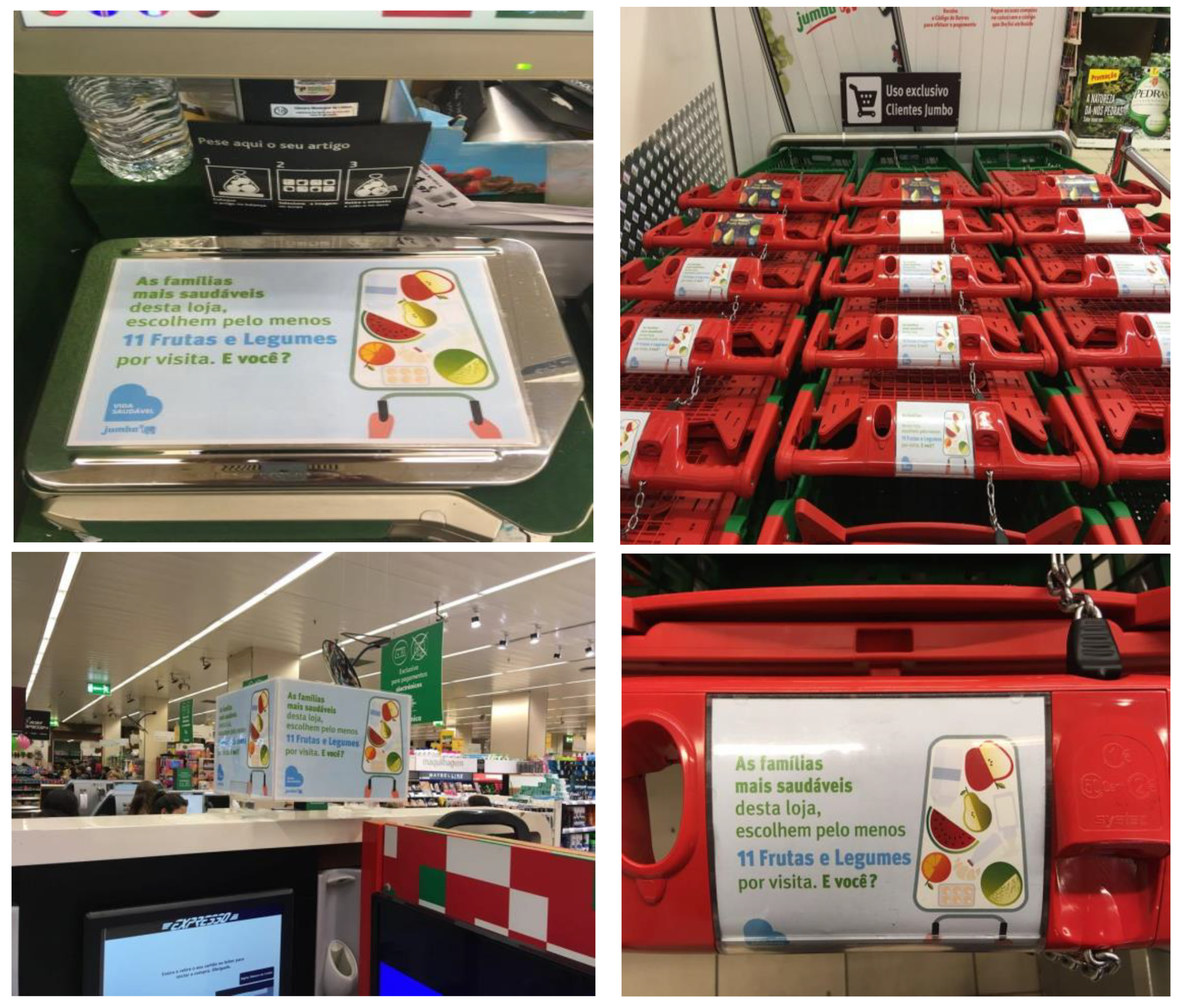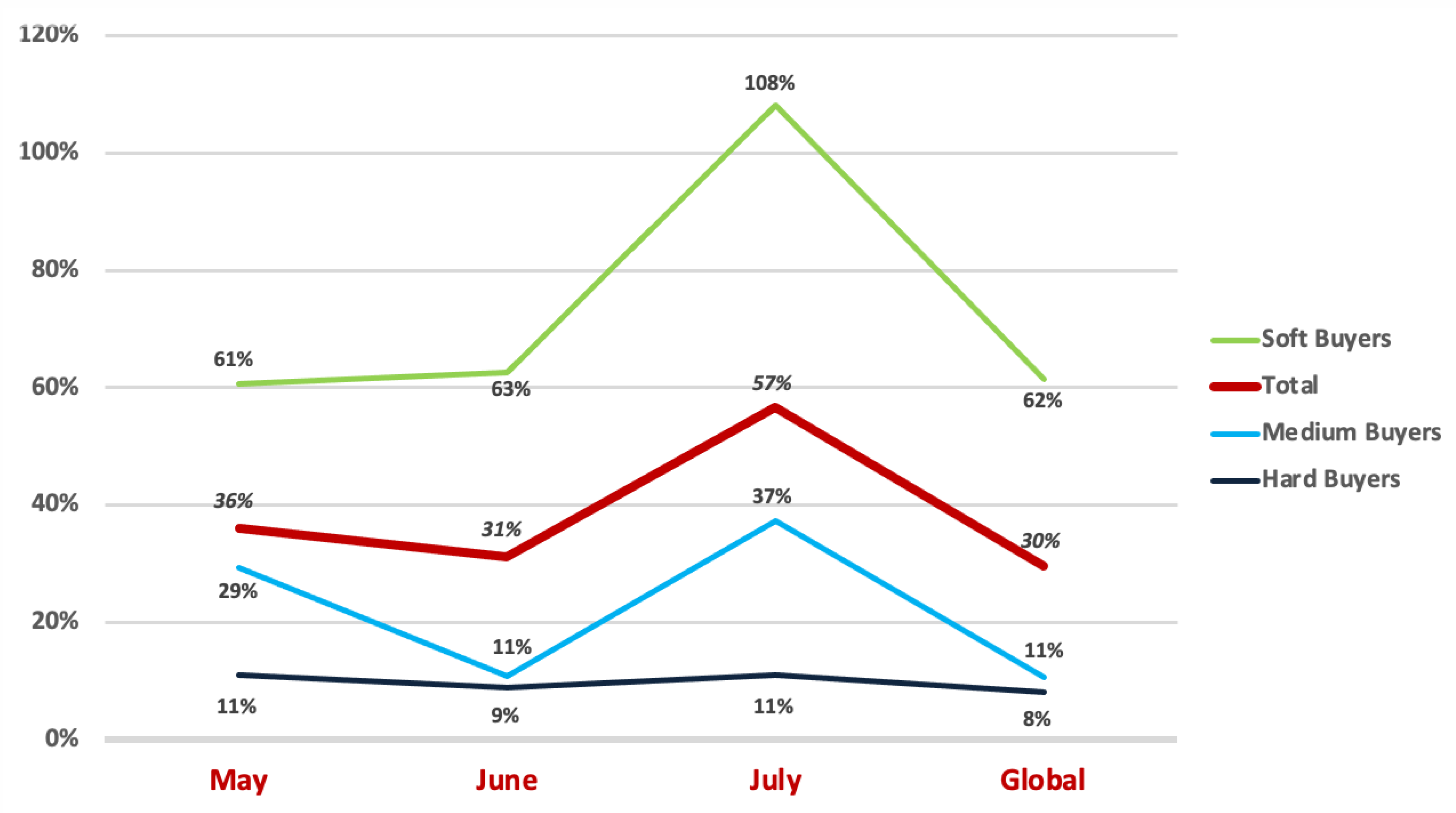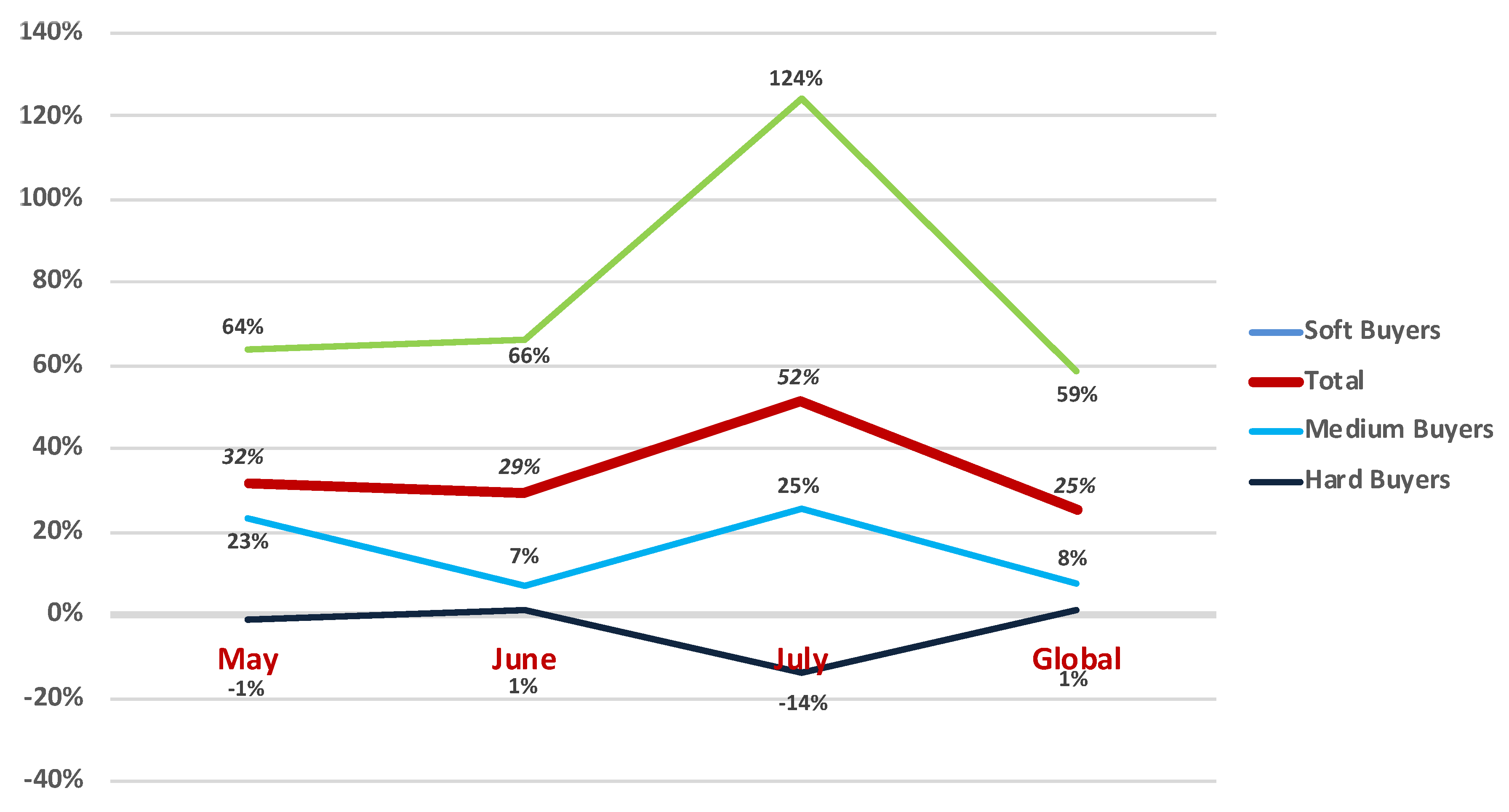Nudging Consumers toward Healthier Food Choices: A Field Study on the Effect of Social Norms
Abstract
1. Introduction
2. Literature Review
2.1. Overview of Nudge
2.2. Social Norms in Nudge Interventions
2.3. Nudge in Health and Food Retail
3. Materials and Methods
3.1. Participants and Procedures
3.2. Segmentation and Variables
4. Results
5. Discussion
5.1. Theoretical Implications
5.2. Practical Implications
5.3. Limitations and Future Research Recommendations
6. Conclusions
Author Contributions
Funding
Institutional Review Board Statement
Informed Consent Statement
Conflicts of Interest
Appendix A

References
- Arocha, R. Sedentarism, a Disease from XXI Century. Clínica E Investig. En Arterioscler. (Engl. Ed.) 2019, 31, 233–240. [Google Scholar]
- WHO. Healthy Diet. Available online: https://www.who.int/news-room/fact-sheets/detail/healthy-diet (accessed on 26 April 2020).
- Lopes, C.; Torres, D.; Oliveira, A.; Severo, M.; Guiomar, S.; Alarcão, V.; Vilela, S.; Ramos, E.; Rodrigues, S.; Oliveira, L.; et al. National food, nutrition and physical activity survey of the Portuguese general population. EFSA Supporting Publ. 2017, 14, 1–37. [Google Scholar] [CrossRef]
- Lopes, C.; Torres, D.; Oliveira, A.; Severo, M.; Alarcão, V.; Guiomar, S.; Mota, J.; Teixeira, P.; Rodrigues, S.; Lobato, L.; et al. National Food, Nutrition, and Physical Activity Survey of the Portuguese General Population, IAN-AF 2015-2016: Summary of Results; 2018; ISBN 978-989-746-202-3. Available online: www.ian-af.up.pt (accessed on 4 December 2020).
- Gaio, V.; Antunes, L.; Namorado, S.; Barreto, M.; Gil, A.; Kyslaya, I. Prevalence of overweight and obesity in Portugal: Results from the first Portuguese Health Examination Survey (INSEF 2015). Obes. Res. Clin. Pract. 2017, 12, 40–50. [Google Scholar] [CrossRef] [PubMed]
- Swinburn, B.; Kraak, V.; Rutter, H.; Vandevijvere, S.; Lobstein, T.; Sacks, G.; Magnusson, R. Strengthening of accountability systems to create healthy food environments and reduce global obesity. Lancet 2015, 385, 2534–2545. [Google Scholar] [CrossRef]
- Bhattarai, N.; Prevost, A.T.; Wright, A.J.; Charlton, J.; Rudisill, C.; Gulliford, M.C. Effectiveness of interventions to promote healthy diet in primary care: Systematic review and meta-analysis of randomized controlled trials. BMC Public Health 2013, 13, 1203. [Google Scholar] [CrossRef] [PubMed]
- Marteau, M.; Hollands, J.; Fletcher, C. Changing human behavior to prevent disease: The importance of targeting automatic processes. Science 2012, 337, 1492–1495. [Google Scholar] [CrossRef]
- Hui, S.; Bradlow, E.; Fader, P. Testing behavioral hypotheses using an integrated model of grocery store shopping path and purchasing behavior. J. Consum. Res. 2009, 36, 478–493. [Google Scholar] [CrossRef]
- Just, D.; Gabrielyan, G. Influencing the food choices of SNAP consumers: Lessons from economics, psychology, and marketing. Food Policy 2018, 79, 309–317. [Google Scholar] [CrossRef]
- Benartzi, S.; Beshears, J.; Milkman, K.L.; Sunstein, C.R.; Thaler, R.H.; Shankar, M.; Galing, S. Should governments invest more in nudging? Psychol. Sci. 2017, 28, 1041–1055. [Google Scholar] [CrossRef]
- Thaler, R.; Sunstein, C. Nudge: Improving Decisions about Health, Wealth, and Happiness; Yale University Press: New York, NY, USA, 2008. [Google Scholar]
- Mollen, S.; Rimal, R.N.; Ruiter, R.A.; Kok, G. Healthy and unhealthy social norms and food selection. Findings from a field-experiment. Appetite 2013, 65, 83–89. [Google Scholar] [CrossRef]
- Burger, J.M.; Bell, H.; Harvey, K.; Johnson, J.; Stewart, C.; Dorian, K.; Swedroe, M. Nutritious or delicious? The effect of descriptive norm information on food choice. J. Soc. Clin. Psychol. 2010, 29, 228–242. [Google Scholar] [CrossRef]
- Abrahamse, W.; Steg, L.; Vlek, C.; Rothengatter, T. A review of intervention studies aimed at household energy conservation. J. Environ. Psychol. 2005, 25, 273–291. [Google Scholar] [CrossRef]
- Steg, L.; Vlek, C. Encouraging pro-environmental behavior: An integrative review and research agenda. J. Environ. Psychol. 2009, 29, 309–317. [Google Scholar] [CrossRef]
- Reisch, L.; Gwozdz, W. Smart defaults and soft nudges: How insights from behavioral economics can inform effective nutrition policy. In Marketing, Food and the Consumer: Festschrift in Honour of Klaus G. Grunert; Scholderer, J., Brunsø, K., Eds.; Pearson Education Ltd.: London, UK, 2013; pp. 189–200. [Google Scholar]
- Sunstein, C.; Thaler, R. Libertarian Paternalism Is Not an Oxymoron. Univ. Chic. Law Rev. 2003, 70, 1159–1202. [Google Scholar] [CrossRef]
- Blumenthal-Barby, J.; Burroughs, H. Seeking better health care outcomes: The ethics of using the “nudge”. Am. J. Bioeth. 2012, 12, 1–10. [Google Scholar] [CrossRef]
- Goodwin, T. Why we should reject ‘nudge’. Politics 2012, 32, 85–92. [Google Scholar] [CrossRef]
- Sunstein, C.; Reisch, L. Green by default. Kyklos 2013, 66, 398–402. [Google Scholar] [CrossRef]
- Hausman, D.; Welch, B. To nudge or not to nudge. J. Political Philos. 2010, 18, 123–136. [Google Scholar] [CrossRef]
- Reisch, L.; Oehler, A. Behavioral economics: Eine neue Grundlage für die Verbraucherpolitik? Vierteljahr. Zur Wirtsch 2009, 78, 30–43. [Google Scholar] [CrossRef]
- Bucher, T.; Collins, C.; Rollo, M.; McCaffrey, T.; Vlieger, N.; Bend, D.; Perez-Cueto, F. Nudging consumers towards healthier choices: A systematic review of positional influences on food choice. Br. J. Nutr. 2016, 115, 2252–2263. [Google Scholar] [CrossRef]
- House of Lords. Behaviour Change, Second Report 2011. Available online: https://old.parliament.uk/business/committees/committees-a-z/lords-select/science-and-technology-committee/inquiries/behaviour/ (accessed on 30 April 2020).
- Clapp, J.; McDonnell, A. The relationship of perceptions of alcohol promotion and peer drinking norms to alcohol problems reported by college students. J. Coll. Stud. Dev. 2000, 41, 19–26. [Google Scholar]
- Perkins, W.; Berkowitz, D. Perceiving the community norms of alcohol use among students: Some research implications for campus alcohol education programming. Int. J. Addict. 1986, 21, 961–976. [Google Scholar] [CrossRef] [PubMed]
- Borsari, B.; Carey, K. Descriptive and injunctive norms in college drinking: A meta-analytic integration. J. Stud. Alcohol 2003, 64, 331–341. [Google Scholar] [CrossRef] [PubMed]
- Prentice, A.; Miller, T. Pluralistic ignorance and alcohol use on campus: Some consequences of misperceiving the social norm. J. Personal. Soc. Psychol. 1993, 64, 243–256. [Google Scholar] [CrossRef]
- Donaldson, S.; Graham, J.; Piccinin, A.; Hansen, W. Resistance-skills training and the onset of alcohol use: Evidence for beneficial and potentially harmful effects in public schools and in private Catholic schools. Health Psychol. 1995, 14, 291–300. [Google Scholar] [CrossRef]
- Cialdini, R.; Kallgren, C.; Reno, R.R. A focus theory of normative conduct. Adv. Exp. Soc. Psychol. 1991, 24, 201–234. [Google Scholar]
- Perkins, W.; Haines, P.; Rice, R. Misperceiving the college drinking norm and related problems: A nationwide study of exposure to prevention information, perceived norms and student alcohol misuse. J. Stud. Alcohol 2005, 66, 470–478. [Google Scholar] [CrossRef]
- Wechsler, H.; Nelson, T.; Lee, J.; Seiberg, M.; Lewis, C.; Keeling, R. Perception and reality: A national evaluation of social norms marketing interventions to reduce college students’ heavy alcohol use. Q. J. Stud. Alcohol 2003, 64, 484–494. [Google Scholar] [CrossRef] [PubMed]
- Robinson, E.; Thomas, J.; Aveyard, P.; Higgs, S. What everyone else is eating: A systematic review and meta-analysis of the effect of informational eating norms on eating behavior. J. Acad. Nutr. Diet. 2014, 114, 414–429. [Google Scholar] [CrossRef]
- Berkowitz, A. An overview of the social norms approach. In Changing the Culture of College Drinking: A Socially Situated Health Communication Campaign; Lederman, L.C., Stewart, L.P., Eds.; Hampton Press Inc.: Cresskill, NJ, USA, 2005; pp. 193–214. [Google Scholar]
- Reno, R.; Cialdini, R.; Kallgren, C. The transsituational influence of social norms. J. Personal. Soc. Psychol. 1993, 64, 104–112. [Google Scholar] [CrossRef]
- Cialdini, R.; Goldstein, J. Social influence: Compliance and conformity. Annu. Rev. Psychol. 2004, 55, 591–622. [Google Scholar] [CrossRef]
- Schultz, W.; Nolan, J.; Cialdini, R.; Goldstein, N.; Griskevicius, V. The Constructive, destructive, and reconstructive power of social norms. Psychol. Sci. 2007, 18, 429–434. [Google Scholar] [CrossRef]
- Schwartz, M. The influence of a verbal prompt on school lunch fruit consumption: A pilot study. Int. J. Behav. Nutr. Phys. Act. 2007, 4, 6. [Google Scholar] [CrossRef]
- Kongsbak, I.; Skov, L.; Nielsen, B.; Ahlmann, F.; Schaldemose, H.; Atkinson, L.; Pérez-Cueto, F. Increasing fruit and vegetable intake among male university students in an ad libitum buffet setting: A choice architectural nudge intervention. Food Qual. Prefer. 2016, 49, 183–188. [Google Scholar] [CrossRef]
- Broers, V.; Breucker, C.; Broucke, S.; Luminet, O. A systematic review and meta-analysis of the effectiveness of nudging to increase fruit and vegetable choice. Eur. J. Public Health 2017, 27, 912–920. [Google Scholar] [CrossRef]
- Wansink, B.; Painter, J.; Ittersum, K. Descriptive menu labels’ effect on sales. Cornell Hotel Restaur. Adm. Q. 2001, 42, 68–72. [Google Scholar]
- Goldberg, M.; Gunasti, K. Creating an environment in which youths are encouraged to eat a healthier diet. J. Public Policy Mark. 2007, 26, 162–181. [Google Scholar] [CrossRef]
- Romero, M.; Biswas, D. Healthy-left, unhealthy-right: Can displaying healthy items to the left (versus right) of unhealthy items nudge healthier choices? J. Consum. Res. 2016, 43, 103–112. [Google Scholar] [CrossRef]
- Chandon, P.; Wansink, B. Does food marketing need to make us fat? A review and solutions. Nutr. Rev. 2012, 70, 571–593. [Google Scholar] [CrossRef] [PubMed]
- Wansink, B. Change their choice! Changing behavior using the CAN approach and activism research. Psychol. Mark. 2015, 32, 486–500. [Google Scholar] [CrossRef]
- Desai, K.K.; Trivedi, M. Do consumer perceptions matter in measuring choice variety and variety seeking? J. Bus. Res. 2014, 67, 2786–2792. [Google Scholar] [CrossRef]
- Hsu, C. Weight Primary Reason for Increase in Tofu Consumption 2014. Available online: https://www.counselheal.com/articles/10425/20140710/weight-primary-reason-increase-tofu-consumption.htm (accessed on 29 April 2020).
- Wilson, N.; Just, D.; Swiger, J.; Wansink, B. Food pantry selection solutions: A randomized controlled trial in client-choice food pantries to nudge clients to targeted foods. J. Public Health 2016, 39, 366–372. [Google Scholar] [CrossRef] [PubMed]
- Hampson, D.; McGoldrick, P. A typology of adaptive shopping patterns in recession. J. Bus. Res. 2013, 66, 831–838. [Google Scholar] [CrossRef]
- Cawley, J.; Hanks, A.; David, R.; Wansink, B. Incentivizing nutritious diets: A field experiment of relative price changes and how they are framed. Work. Pap. Ser. (Natl. Bur. Econ. Res.) 2016. [Google Scholar] [CrossRef]
- Stein, K. Eyes in an aisle: How eye gaze level relates to healthy grocery store purchases. In Working Paper 2018; Cornell University Food and Brand Lab.: Ithaca, NY, USA, 2018. [Google Scholar]
- Bhana, H. Conducting behavioral field research in food pantries: Lessons and tactics for testing nutrition interventions. In Working Paper 2017; Columbia University: New York, NY, USA, 2017. [Google Scholar]
- Payne, R.; Niculescu, M.; Just, D.; Kelly, M. Shopper marketing nutrition interventions. Physiol. Behav. 2014, 136, 111–120. [Google Scholar] [CrossRef]
- Wansink, B. Healthy profits: An interdisciplinary retail framework that increases the sales of healthy foods. J. Retail. 2017, 93, 65–78. [Google Scholar] [CrossRef]
- Ailawadi, K.L.; Ma, Y.; Grewal, D. The club store effect: Impact of shopping in warehouse club stores on consumers’ packaged food consumption. J. Mark. Res. 2018, 55, 193–207. [Google Scholar] [CrossRef]
- Hoenink, J.C.; Mackenbach, J.D.; Waterlander, W.; Lakerveld, J.; van der Laan, N.; Beulens, J.W.J. The effects of nudging and pricing on healthy food purchasing behavior in a virtual supermarket setting: A randomized experiment. Int. J. Behav. Nutr. Phys. Act. 2020, 17, 1–12. [Google Scholar] [CrossRef]
- Pope, L.; Hanks, A.; Just, D.; Wansink, B. New Year’s res-illusions: Food shopping in the New Year competes with healthy intentions. PLoS ONE 2016, 9, e110561. [Google Scholar] [CrossRef] [PubMed]


| May | June | July | Total (3 Months) | |
|---|---|---|---|---|
| Soft (<4) | 670 (40.9%) | 695 (40.6%) | 614 (39.9%) | 1157 (39.1%) |
| Medium (4 to 10) | 420 (25.7%) | 447 (26.1%) | 405 (26.3%) | 830 (28.1%) |
| Hard (>10) | 546 (33.4%) | 569 (33.3%) | 521 (33.8%) | 969 (32.8%) |
| Total | 1636 | 1711 | 1540 | 2956 |
Publisher’s Note: MDPI stays neutral with regard to jurisdictional claims in published maps and institutional affiliations. |
© 2021 by the authors. Licensee MDPI, Basel, Switzerland. This article is an open access article distributed under the terms and conditions of the Creative Commons Attribution (CC BY) license (http://creativecommons.org/licenses/by/4.0/).
Share and Cite
Gonçalves, D.; Coelho, P.; Martinez, L.F.; Monteiro, P. Nudging Consumers toward Healthier Food Choices: A Field Study on the Effect of Social Norms. Sustainability 2021, 13, 1660. https://doi.org/10.3390/su13041660
Gonçalves D, Coelho P, Martinez LF, Monteiro P. Nudging Consumers toward Healthier Food Choices: A Field Study on the Effect of Social Norms. Sustainability. 2021; 13(4):1660. https://doi.org/10.3390/su13041660
Chicago/Turabian StyleGonçalves, Diogo, Pedro Coelho, Luis F. Martinez, and Paulo Monteiro. 2021. "Nudging Consumers toward Healthier Food Choices: A Field Study on the Effect of Social Norms" Sustainability 13, no. 4: 1660. https://doi.org/10.3390/su13041660
APA StyleGonçalves, D., Coelho, P., Martinez, L. F., & Monteiro, P. (2021). Nudging Consumers toward Healthier Food Choices: A Field Study on the Effect of Social Norms. Sustainability, 13(4), 1660. https://doi.org/10.3390/su13041660








